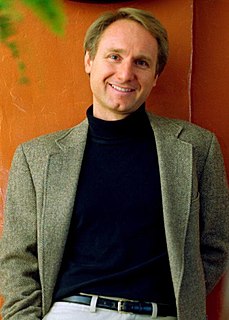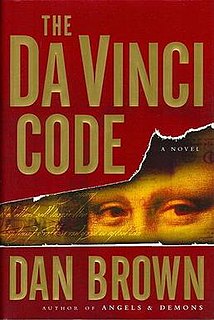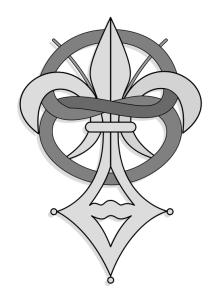
Merovech was the King of the Salian Franks, which later became the dominant Frankish tribe, and the founder of the Merovingian dynasty. Several legends and myths surround his person. He is proposed to be one of several barbarian warlords and kings that joined forces with the Roman general Aetius against the Huns under Attila at the Battle of the Catalaunian Plains in Gaul in 451. His grandson Clovis I became the founder of the Frankish kingdom.

A Bible conspiracy theory is any conspiracy theory that posits that much of what is believed about the Bible is a deception created to suppress some secret, ancient truth. Some of these theories claim that Jesus really had a wife and children, or that a group such as the Priory of Sion has secret information about the true descendants of Jesus; some claim that there was a secret movement to censor books that truly belonged in the Bible, etc.

Daniel Gerhard Brown is an American author best known for his thriller novels, including the Robert Langdon novels Angels & Demons (2000), The Da Vinci Code (2003), The Lost Symbol (2009), Inferno (2013), and Origin (2017). His novels are treasure hunts which usually take place over a period of 24 hours. They feature recurring themes of cryptography, art, and conspiracy theories. His books have been translated into 57 languages and, as of 2012, have sold over 200 million copies. Three of them, Angels & Demons, The Da Vinci Code, and Inferno, have been adapted into films.

The Da Vinci Code is a 2006 American mystery thriller film directed by Ron Howard, written by Akiva Goldsman, and based on Dan Brown's 2003 novel of the same name. The first in the Robert Langdon film series, the film stars Tom Hanks, Audrey Tautou, Sir Ian McKellen, Alfred Molina, Jürgen Prochnow, Jean Reno and Paul Bettany. In the film, Robert Langdon, a professor of religious symbology from Harvard University, is the prime suspect in the grisly and unusual murder of Louvre curator Jacques Saunière. On the body, the police find a disconcerting cipher and start an investigation. Langdon escapes with the assistance of police cryptologist Sophie Neveu, and they begin a quest for the legendary Holy Grail. A noted British Grail historian, Sir Leigh Teabing, tells them that the actual Holy Grail is explicitly encoded in Leonardo da Vinci's wall painting, The Last Supper. Also searching for the Grail is a secret cabal within Opus Dei, an actual prelature of the Holy See, who wish to keep the true Grail a secret to prevent the destruction of Christianity.

The Jesus Mysteries: Was the "Original Jesus" a Pagan God? is a 1999 book by British authors Timothy Freke and Peter Gandy, which advances the argument that early Christianity originated as a Greco-Roman mystery cult and that Jesus was invented by early Christians based on an alleged pagan cult of a dying and rising "godman" known as Osiris-Dionysus, whose worship the authors claim was manifested in the cults of Osiris, Dionysus, Attis, and Mithras.
Lynn Picknett is a writer of books that are mainly about pseudo-history and popular conspiracy theories, the paranormal, the occult, and historical and religious mysteries.
Michael Baigent was a writer, who published a number of popular works questioning traditional perceptions of history and the life of Jesus. He is best known as a co-author of the book The Holy Blood and the Holy Grail.
The Da Vinci Code, a popular suspense novel by Dan Brown, generated criticism and controversy after its publication in 2003. Many of the complaints centered on the book's speculations and misrepresentations of core aspects of Christianity and the history of the Catholic Church. Additional criticisms were directed toward the book's inaccurate descriptions of European art, history, architecture, and geography.
Richard Harris Leigh was a novelist and short story writer born in New Jersey, United States to a British father and an American mother, who spent most of his life in the UK. Leigh earned a BA from Tufts University, a master's degree from the University of Chicago, and a PhD from the State University of New York at Stony Brook.

The Dead Sea Scrolls Deception is a book by authors Michael Baigent and Richard Leigh. Rejecting the established scholarly consensus that the Dead Sea scrolls were the work of a marginal Jewish apocalyptic movement, and following primarily the thesis of Robert Eisenman, the authors argue that the scrolls were the work of Jewish zealots who had much in common with, and may have been identical to, the early followers of Jesus led by his brother James the Just. Their unconventional hypothesis provides a different version of the history of early Christianity and challenges the divinity of Jesus.

The Da Vinci Code is a 2003 mystery thriller novel by Dan Brown. It is Brown's second novel to include the character Robert Langdon: the first was his 2000 novel Angels & Demons. The Da Vinci Code follows symbologist Robert Langdon and cryptologist Sophie Neveu after a murder in the Louvre Museum in Paris causes them to become involved in a battle between the Priory of Sion and Opus Dei over the possibility of Jesus Christ and Mary Magdalene having had a child together.
The Jesus bloodline refers to the proposition that a lineal sequence of descendants of the historical Jesus has persisted to the present time. The claims frequently depict Jesus as married, often to Mary Magdalene, and as having descendants living in Europe, especially France but also the UK. Differing and contradictory Jesus bloodline scenarios, as well as more limited claims that Jesus married and had children, have been proposed in numerous modern books. Some such claims have suggested that Jesus survived the crucifixion and went to another location such as France, India or Japan.
The Institute for Religious Research (IRR) is an American Christian apologetics and counter-cult organization based in Cedar Springs, Michigan. It declares itself to be a non-denominational, non-profit Christian foundation for the study of religious claims, and was formerly known as Gospel Truths Ministries. IRR is a member of Evangelical Ministries to New Religions and was headed by Luke P. Wilson until his death in 2007. IRR's current staff includes Robert M. Bowman Jr. as executive director.
The Woman with the Alabaster Jar: Mary Magdalene and the Holy Grail is a book written by Margaret Starbird in 1993, claiming Jesus Christ and Mary Magdalene were married, and that Mary Magdalene was the Holy Grail.

The Prieuré de Sion, translated as Priory of Sion, was a fraternal organization founded in France in 1956 by Pierre Plantard in his failed attempt to create a prestigious neo-chivalric order. In the 1960s, Plantard began claiming that his self-styled order was the latest front for a secret society founded by crusading knight Godfrey of Bouillon, on Mount Zion in the Kingdom of Jerusalem in 1099, under the guise of the historical monastic order of the Abbey of Our Lady of Mount Zion. As a framework for his grandiose assertion of being both the Great Monarch prophesied by Nostradamus and a Merovingian pretender, Plantard further claimed the Priory of Sion was engaged in a centuries-long benevolent conspiracy to install a secret bloodline of the Merovingian dynasty on the thrones of France and the rest of Europe. To Plantard's surprise, all of his claims were fused with the notion of a Jesus bloodline and popularised by the authors of the 1982 speculative nonfiction book The Holy Blood and the Holy Grail, whose conclusions would later be borrowed by Dan Brown for his 2003 mystery thriller novel The Da Vinci Code.
Henry Soskin, better known as Henry Lincoln, was a British author, television presenter, scriptwriter, and actor. He co-wrote three Doctor Who multi-part serials in the 1960s, and — starting in the 1970s — inspired three Chronicle BBC Two documentaries on the alleged mysteries surrounding the French village of Rennes-le-Château — and, from the 1980s, co-authored and authored a series of books of which The Holy Blood and the Holy Grail was the most popular, becoming the inspiration for Dan Brown's 2003 best-selling novel, The Da Vinci Code. He was the last living person to have written for Doctor Who in the 1960s.

The Holy Blood and the Holy Grail is a book by Michael Baigent, Richard Leigh, and Henry Lincoln.
Cannibalization of fiction refers to adapting, borrowing or stealing plots, characters, themes or ideas from one story for use in another or from one medium to another, such as a film adaptation of a book.

The Gospel of Jesus' Wife is a papyrus fragment with Coptic text that includes the words, "Jesus said to them, 'my wife...'". The text received widespread attention when first publicized in 2012 for the implication that some early Christians believed that Jesus was married.
The Fifth Gospel, first published in Germany in 1993, is a novel by Philipp Vandenberg.










